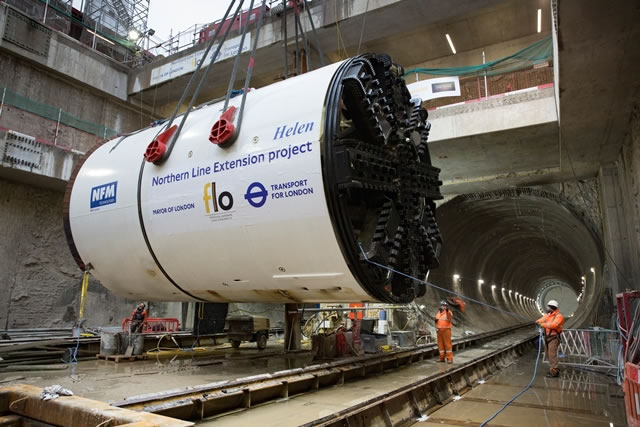Huge Crane Lowers Northern Line Extension Tunnelling Giants Into Place
'Helen' and 'Amy' will carve out 3.2km for the new Tube line

'Helen' - one of the two giant tunnel boring machines
A major milestone in the construction of the Northern Line Extension has been reached with the lowering of two giant tunnel boring machines 20 metres below ground in Battersea, ahead of tunnelling starting in March.
The precision operation required a huge 750-tonne crane to lift the two tunnel boring machines, Helen and Amy, in the shadow of London’s iconic Battersea Power Station.
According to tunnelling tradition, the machines cannot start work until given a name and, following a vote by local school children, were named in honour of the first British astronaut, Helen Sharman, and British aviation pioneer, Amy Johnson, who was the first female pilot to fly solo from Britain to Australia.
The two tunnel boring machines will create two 3.2km underground tunnels to extend the Charing Cross branch of the Northern line from Kennington to Battersea Power Station, via Nine Elms Station. Tunnelling will take six months to complete.
As well as two new tunnels, two new stations are being created - one at the heart of the Battersea Power Station redevelopment and another at Nine Elms to the east, serving new developments such as the US Embassy and the redevelopment of New Covent Garden Market, as well as existing communities.
The extension, targeted for completion in 2020, is the first major Tube line extension since the Jubilee line in the late 1990s.
Both tunnelling machines will now be fully assembled within two 77m long launch tunnels, before starting their journeys towards Kennington next month. When fully assembled, Helen and Amy will each be 100 metres in length and will excavate more than 300,000 tonnes of earth. This will then be passed along conveyors before being loaded on to barges and taken to Goshems Farm in East Tilbury, Essex, where it will be used to create arable farmland. This will remove more than 40,000 lorry journeys from the Capital’s roads, reducing congestion.
March 1, 2017